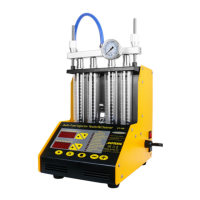
Do you have a question about the Autool CT150 and is the answer not in the manual?
| Brand | Autool |
|---|---|
| Model | CT150 |
| Category | Cleaning Equipment |
| Language | English |
Covers electrical safety, fire prevention, environmental conditions, and personal protection during operation.
Overview of the AUTOOL CT200/CT150 injector cleaning detector.
Cleans multiple injectors simultaneously, removing carbon deposits.
Checks injector output uniformity and spray pattern.
Assesses injector sealing and detects drips under pressure.
Measures injector output over 15 seconds of constant injection.
Simulates various working conditions for injector testing.
Facilitates cleaning injectors directly on the vehicle using adaptors.
Details operating temperature, humidity, power supply, and frequency.
Lists fuel tank capacity, cylinder volume, speed, pulse width, and pressure settings.
Identifies main parts like the ultrasonic cleaner, control panel, and connectors.
Describes the LED screen, buttons (Start, Stop, Pause), and pressure indicators.
Guides on injector removal, seal inspection, fluid filling, and power activation.
Outlines the recommended order for cleaning and testing injector functions.
Steps for draining fluid and powering down the equipment.
Details powering the cleaner, placing injectors, and adding cleaning liquid.
Explains how to assess injector performance and electrical characteristics.
Covers inserting signal lines, setting time, and ending the ultrasonic cleaning process.
Describes connecting signal lines and running the uniformity test.
Instructions for pouring out cleaning liquid and wiping the unit.
Provides specific parameters and comparison guidelines for uniformity and atomization.
Step-by-step guide for installing up-inlet injectors and initiating testing.
Step-by-step guide for installing side-inlet injectors and initiating testing.
Steps for cleaning the ultrasonic tank and machine table.
Guidance on interpreting test results for uniformity and atomization.
Instructions for cleaning the ultrasonic cleaner and preparing for the next job.
Further details on analyzing injector electrical characteristics and spray patterns.
Procedures for cleaning the ultrasonic cleaner and fuel tank.
Explains how to adjust cylinder number and system pressure for testing.
Final steps for cleaning the ultrasonic cleaner and table.
Discusses deviation limits and simulation of working conditions.
Steps for cleaning and storing the ultrasonic cleaning liquid.
Details on switching between uniformity/atomization and adjusting pressure.
Final cleaning steps for the ultrasonic cleaner and table.
Guides on liquid level, deviation, and minimum opening pulse width.
Instructions for connecting fittings and installing injectors for reverse flush.
Steps before initiating the leakage test, including draining fluid.
Details on running the test, adjusting pressure, and observing for drips.
Guides on disconnecting fuel hoses and connecting the unit.
Diagram illustrating the hose connections for on-vehicle cleaning.
Instructions for connecting the unit without a return hose for on-vehicle cleaning.
Steps for restoring connections, checking for leaks, and cleaning the system.
Outlines the warranty period for the main unit and accessories.
Details on repair/replacement, proof of breakdown, and freight costs.
Lists conditions under which warranty is voided, like non-official purchase or misuse.
Notifies users about potential changes in product design and specifications without notice.